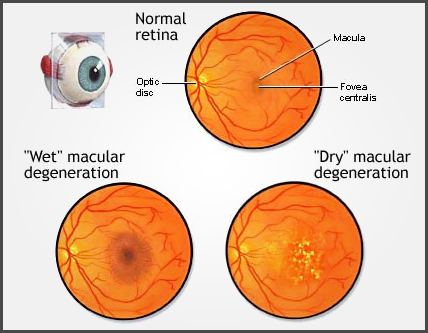Age-related macular degeneration (AMD) is the leading cause of vision loss in people over the age of 60. The disease affects the retina, the paper-thin tissue lining the back of the eye.
In the very center of the retina is the macula, which contains the highest concentration of light-sensitive cells, called cones.
- Cones provide sharp, detailed, central vision used in activities like driving and reading.
- In macular degeneration, cells in the macular region begin to die, causing blind spots and distorted central vision.
The two types of macular degeneration are dry and wet.
- People can develop both types of the disease.
- The disease can affect one or both eyes.
- The disease may progress slowly or rapidly.
Dry macular degeneration may advance and cause vision loss with or without turning into the wet type of the disease. However, not everyone with early AMD will develop the advanced form of the disease.
- Dry form. The “dry” form of macular degeneration is characterized by the presence of yellow deposits, called drusen, in the macula. A few small drusen may not cause changes in vision; however, as they grow in size and increase in number, they may lead to a dimming or distortion of vision that people find most noticeable when they read. In more advanced stages of dry macular degeneration, there is also a thinning of the light-sensitive layer of cells in the macula leading to atrophy, or tissue death. In the atrophic form of dry macular degeneration, patients may have blind spots in the center of their vision. In the advanced stages, patients lose central vision.
- Wet form. The “wet” form of macular degeneration is characterized by the growth of abnormal blood vessels from the choroid underneath the macula. This is called choroidal neovascularization. These blood vessels leak blood and fluid into the retina, causing distortion of vision that makes straight lines look wavy, as well as blind spots and loss of central vision. These abnormal blood vessels and their bleeding eventually form a scar, leading to permanent loss of central vision.
Until recently, there was no medication for either type, but today we have help for wet macular degeneration. The best way to follow both types is with retinal photos and an OCT. Both of these cutting edge technologies are available at eyegotcha. Call today for an appointment to see if you have macular degeneration, or if you are a candidate for the medication. (412.331.9696)
https://www.brightfocus.org/macular/types
https://www.webmd.com/eye-health/macular-degeneration/age-related-macular-degeneration-overview#1

